The job of a solution architect is always mistakenly associated with building and selling technologies. But if that’s not it, then what is?
Microsoft Area Solution Architect for Asia Pacific Newson Ng likens his job to that of a soccer coach.
He shared: “Their psyche is very similar to an architect – what system is the best for a particular match, technological components to use, and security aspects to look into. There’s also the human element to it. You enable those with potential to become champions. When I see my customer score a goal, I will be at the sidelines going crazy. Once they do it, they will get addicted and want to do another project again.”
Contrary to popular belief, Newson seldom talk about technicalities and technologies with his clients. Essentially, his role sits before the technology adoption phase, identifying the roots of business problems and recommending the solutions necessary to fix them.
As part of the job, Newson goes for site visits to understand company processes and holds multiple discussions with his clients on the steps to take towards digital transformation.
“Advising has the connotation that I know it all, but I don’t think that’s the case. I’m here to listen and learn, all their concerns and difficulties. A good architect will always want to engage their customers.
“A lot of the times people decide with their heart, then rationalise with their mind. That’s why you need to empathise and understand first, then show them the possibilities technology can bring,” emphasised Newson, who has been with Microsoft for six years.
Inside the Job
Newson entered the local IT sector in 1999 after completing his degree in computing in Australia. As a system analyst, he helped to digitalise documents, fix database errors, write customised scripts and manage various IT projects.
From 2002 onwards, he started his career as a solution architect in companies such as Hewlettt-Packard, Dimension Data and now, Microsoft. There are 20 solution architects at Microsoft who are based in Singapore.
“Sometimes it’s not the technical things that they fear, it’s the unknown. There’s a saying – people like changes, but not much; people like changes, but who wants to change? A large part of my job is about explaining things, never about selling. Once you explain, then they have that ‘aha!’ moment; ‘why didn’t I think of that before?’. I create the excitement, the energy,” explained Newson.
Once his clients agreed on the technologies to adopt, Newson will link them up with Microsoft’s tech domain team to help with the implementation.
Using a mix of artificial intelligence, cloud solutions, and business applications, Microsoft helps clients achieve any of these four objectives: engage customers, empower employees, optimise operations, and transform products and services.
Modern Workplaces
To get inspiration and food for thought, the 41-year-old reads a lot. His favourite books are on how technology is shifting behaviours and lifestyles. To keep abreast of business and IT trends, Newson also takes two to four hours a week to complete bite-sized courses on EDX or Coursera.
Newson channels his knowledge to help his clients evolve their business and design modern workplaces.
He shared: “Sometimes I tell my businesses, evolving is not about being trendy. Your customers’ behaviour has changed. How do you still make yourself relevant?”

If ever there are doubts from his clients about why there is a need to evolve or what could he help to solve, Newson often raise provoking questions about industry disruptions such as the ones below.
Wi-Fi: Everyone now has the ability to work everywhere without a network cable. Hot-desking and telecommuting can now be explored. Suddenly, co-working spaces bring new business opportunities in the property scene.
- How can businesses transit to co-working spaces to avoid high office rent without compromising the level of prestige? How do you create a collaborative culture there?
Mobile: Life and work are intertwined. There’s no barrier. Your boss can communicate on Whatsapp. In the past, information seemed to be guarded, now it’s blurred, you carry it everywhere.
- Security threats are largely the same, but the battlefield changes – it’s no longer just within the office. How do you stay protected?
Shell economy: People no longer want to own things. We no longer collect DVDs, we Netflix it. We are all just consuming. Carousell is also gaining in popularity. Why do I need to own something that I use once or twice?
- It’s the same for people selling cars and equipment. People just want to rent them now. How should you change your products and business models then?
Millennials: More and more millennials look for recommendations on forums and social media. It’s no longer the traditional way where people visit physical shops to touch and feel, and talk to the salespeople. Many companies are also finding it hard to attract and retain millennials.
- How do you appeal to millennials in terms of marketing and working environment? Is there a tech gap? It requires a lot of design thinking.
E-commerce: If you just want to list your products, you can get higher reach on major marketplaces such as Qoo10 and Lazada.
- If you want to start an online store, make it intelligent. Find out customers’ searching patterns, why they add things in their shopping carts but never check out, and how and when is the best time to give them a nudge.
BONUS: Watch Microsoft’s Techy Solutions in Action
Try on products in virtual reality.
Software that provides crowd insights such as demographics and emotions in real-time.

